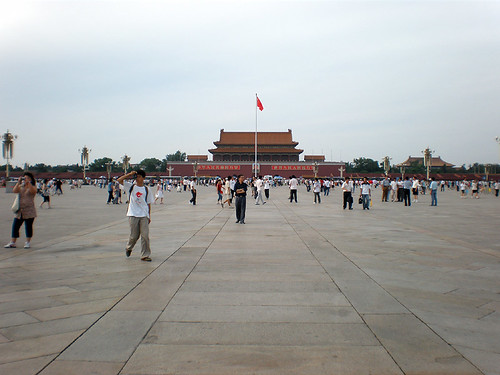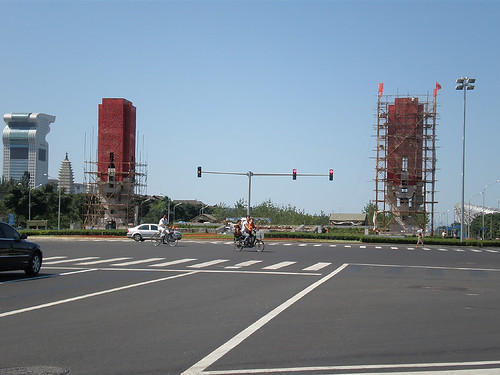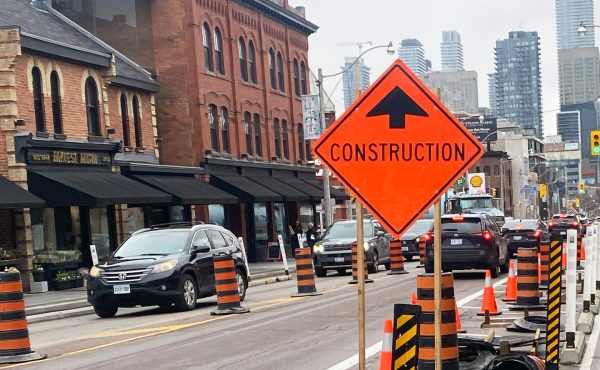
Spacing correspondent Megan Hall is in Beijing this summer. Over the next few weeks, she will be sharing her observations of China’s capital as it prepares to welcome the world to the 2008 Olympics.
– – – – – – – – – – – – – – – – – – – – – – – – – – – –
BEIJING, CHINA — A central north-south axis runs directly through the heart of Beijing. Beginning at Qianmen gate, the ‘Dragon Vein’, as it is sometimes called, runs directly through Mao’s mausoleum, straight through Tiananmen Square, and cuts the Forbidden City in half. It then continues overtop of Jingshan, a hill artificially constructed during the Ming dynasty, runs up through the Drum Tower and ends at the Bell Tower, both of which were used to summon the Imperial Court to the Forbidden City during dynastic rule.
In recent years, however, an extension has been made to this perfect meridian. Just 10 kilometres north of the Forbidden City, on either side of the same north-south axis, stands the Bird’s Nest (formally known as the National Stadium), and the Water Cube (the National Aquatic Centre), both built specifically for China’s shining moment that arrives in the coming weeks. This single line defines the new Olympic Green and permits the powerful symmetry to continue straight through north Beijing.

I made many trips to the southern end of the axis since arriving in Beijing but I had yet to witness the newly completed end on the north side, so I got on my bike and headed up. Beijing’s streets are normally lined with trees, busy with people and packed with bicycles. As one approaches the Olympic Green, however, many of these elements taper off. The six-lane Bell Tower Avenue is suddenly divided by a new kind of gate — one that will host the Olympic Torch for only a few weeks in August and September. The Bird’s Nest becomes visible in the background, and large stretches of concrete and new trees indicate the continuation of the important axial divide that now stretches all the way to the 5th ring road — where Beijing becomes patchy with undeveloped land.
The Beijing government gave the job of extending the city’s dividing point and connecting it to the old city to Albert Speer Jr., the son of Hitler’s chief architect. In Jasper Becker’s book City of Heavenly Tranquility, Speer is quoted as saying, “The comparisons with my father are unfortunate but cannot be avoided…What I am trying to do is to transport a 2,000-year-old city into the future.†Exactly how Speer’s extension of the axis brings Beijing into the future is unclear as it now physically connects the new city with the old.

The Olympic site stretches on for many kilometers in every direction and it is only possible to walk from one end to the other if you have an entire day to dedicate to it. Just like Tiananmen Square, the large stretches of concrete were designed to be full of people, but the current emptiness creates an eerie reminder of the approximate 100,000 people that were ‘relocated’ so as to allow for it to be built. Nevertheless, the Olympic buildings are a source of deep pride for the Chinese as they are visible on every other poster, bus and billboard throughout the entire country. They are clearly the images that the government wishes to project as symbols for the New China.
One of the Maoist policies that led to the destruction of so many parts of Beijing was a rejection of all things old, such as the ancient city gates and many imperial buildings. As a contrast, it is rumoured that during the opening ceremony, China’s entire history will be reenacted and condensed into an hour. If there is a desire to include their past in the benchmark event that will stand for their future then perhaps this is an indication that China wants to present itself to the world with an image unlike one that its own people have been witnessing in recent decades.

Although I’m sure there are many reasons for the extension of the north-south axis, my own hypothesis is two-fold. In recent years the destruction of the old has been rampant throughout Beijing: hutongs are regularly torn down in mass to make way for new developments and historically significant buildings are destroyed to create high-rise apartments. On a hopeful note, perhaps the addition of two of China’s most important buildings on the ancient meridian indicates a step towards appreciating the past and remembering its history. On the other hand, the Bird’s Nest and Water Cube are two monstrous symbols for China’s move to the world stage, and perhaps this modern addition to the traditional national vein of power is intended to indicate the importance of Beijing not only to the rest of China but the importance of China to the rest of the world.
all photos by Megan Hall


One comment
He may be a decent man, but choosing Speer Jr. is bad optics (personally, I would have repudiated my surname if my father had been employed by Nazis to bring about Nazism’s architectual embodiments), and yet, so fitting.
The long list of what China is doing ‘wrong’ in the eyes of a self-satisfied ‘liberal’ west is legion, but irrelevant, because the rest of the world doesn’t care, and we’ve never cared enough to boycott with our athletes, money, or even our journalists – even when their browsing is limited.
The Soviets used to say that America will be hung with rope they sold themselves. That may yet happen.